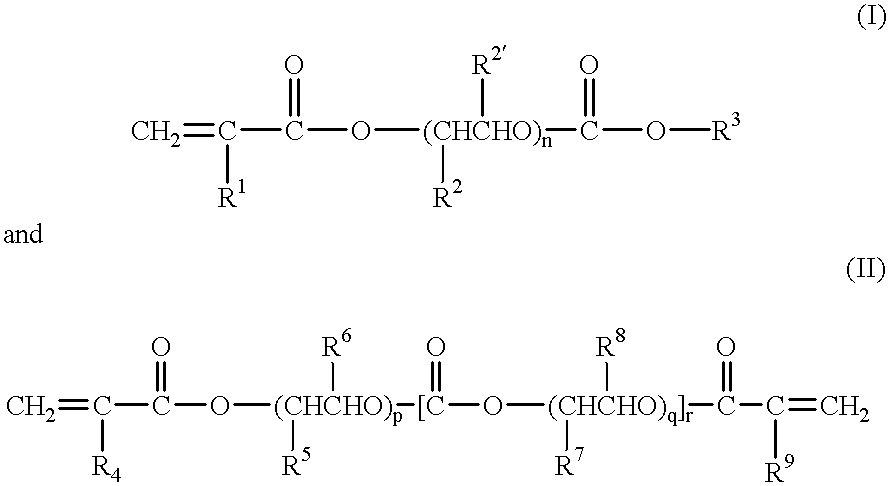Gel-form solid polymer electrolyte
a polymer and gel electrolyte technology, applied in the direction of organic electrolyte cells, conductive materials, non-conductive materials with dispersed conductive materials, etc., can solve the problems of difficult to obtain primary and secondary batteries exhibiting excellent discharge characteristics, unsatisfactory long-term reliability,
- Summary
- Abstract
- Description
- Claims
- Application Information
AI Technical Summary
Benefits of technology
Problems solved by technology
Method used
Image
Examples
example 1
2-Methacryloyloxyethyl methyl carbonate represented by the following formula (V) was used as an acrylic ester monomer:
LiN(CF.sub.3 SO.sub.2).sub.2 as a Group Ia metal salt and Peroyl IPP50 (produced by Nippon Oil & Fats Co., Ltd.) were added to a mixture of 50% by weight of 2-methacryloyloxyethyl methyl carbonate and 50% by weight of propylene carbonate in respective amounts of 2 mol % substrated on the carbonate units and 1 mol % substrated on the acrylic ester monomer. The mixture was homogenized, cast on a glass plate and heated at 70.degree. C. on a hot plate in an inert gas atmosphere for 30 min to thereby make a curing. Thus, a polymeric gel electrolyte having a thickness of about 1 mm was obtained. ##STR13##
This polymeric gel electrolyte was punched into disks having a diameter of 10 mm. The obtained disk was interposed between electrodes secured to a conductivity measuring holder. While controlling the electrodes at 25.degree. C. by Peltier device, a complex impedance measur...
example 2
A polymeric gel electrolyte was produced in the same manner as in Example 1, except that an acrylic ester monomer consisting of a 5:5 molar ratio mixture of 2-methacryloyloxyethyl methyl carbonate and 2(2-methacryloyloxyethoxy)ethyl methyl carbonate represented by the following formula (VI) was used as an acrylic ester: ##STR14##
The ionic conductivity of the obtained polymeric gel electrolyte was measured in the same manner as in Example 1. The results are given in Table 1.
example 3
A polymeric gel electrolyte was produced in the same manner as in Example 1, except that a mixture of 30% by weight of di(2-methacryloylox-yethyl) carbonate represented by the following formula (VII) and 70% by weight of propylene carbonate was used in place of the mixture of 50% by weight of 2-methacryloyloxyethyl methyl carbonate and 50% by weight of propylene carbonate: ##STR15##
The ionic conductivity of the obtained polymeric gel electrolyte was measured in the same manner as in Example 1.
The results are given in Table 1.
PUM
| Property | Measurement | Unit |
|---|---|---|
| Angle | aaaaa | aaaaa |
| Electrical conductivity | aaaaa | aaaaa |
| Electrical conductivity | aaaaa | aaaaa |
Abstract
Description
Claims
Application Information
 Login to View More
Login to View More - R&D Engineer
- R&D Manager
- IP Professional
- Industry Leading Data Capabilities
- Powerful AI technology
- Patent DNA Extraction
Browse by: Latest US Patents, China's latest patents, Technical Efficacy Thesaurus, Application Domain, Technology Topic, Popular Technical Reports.
© 2024 PatSnap. All rights reserved.Legal|Privacy policy|Modern Slavery Act Transparency Statement|Sitemap|About US| Contact US: help@patsnap.com










